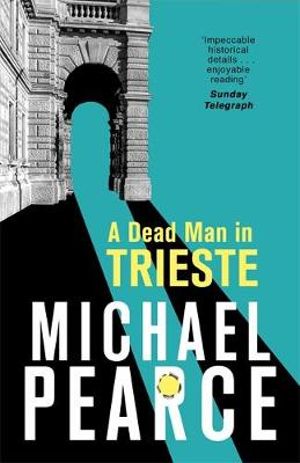A Dead Man in Trieste (2004) by Michael Pearce.
GoodReads meta-data is 320 pages, rated 3.17 from 190 litizens.
Genre: policier.

Verdict: It grew on me.
The first entry is the series Seymour of Special Branch set in 1906. Young Seymour has been recruited to Special Branch due to his several languages, because his anglicised name hides Italian and Russian ancestors, and his ambition. His remit is the docklands of London’s East End — long before it became the upmarket enclave it is today — where migrants speak those languages and more.
Then one fine day he is called to the FO (Foreign Office) from whence he travels to Trieste to find out what has become of the British consul, one Lomax by name, who has gone missing. Because Seymour is not a gentleman by birth some in the FO do not want to send him, but others suggest that his background and work with foreigners equip him for the job. Off he goes.
Ah, Trieste. He finds a different world there which he slowly absorbs and the absent Lomax dominates the story. Seymour poses as a low-level FO messenger charged with reporting on Lomax’s disappearance. He questions the office staff in the consulate, Lomax’s friends, and the police. In doing so he learns about the tensions in Trieste between the Austrian masters and the Italian population leavened with Serbs and Croats, along with the Big Enders and Little Enders. That a Great War might be sparked by a small event is presaged with a heavy hand.
Even better is the slow development of a picture of Lomax, who at first blush seemed to be an alcoholic idler, but as Seymour peels away the surface he finds depths in Lomax: ethical, technical, artistic, and political, belied by his al fresco life at a café.
In a minor register the tug of war between the city police, who are Italian, and the Austrian secret police is well handled. They cooperate reluctantly but are bitter rivals for status and budget. Linguistic nationalism is one of the master narratives.
The futurist artists with whom Lomax mixed are also brought to life that made me appreciate Italian Futurism’s effort to break with the past through art.
The parallel to the murder the Archduke at Sarajevo is evoked quite explicitly with unerring hindsight. Likewise Seymour’s dalliance with the only young woman in the novel is strictly routine. On the plus side, Seymour does grow up a little in the story, and thinks twice about some premature conclusions, particularly about Lomax.

I read it while we were in (the once Free Territory of) Trieste: having seen Miramar, Casa Revoltella, the grand canal, piazza central, and so on.

